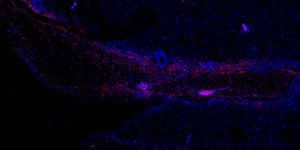Two Studies Reveal New Details About Memory and Learning
Research has indicated that when a protein called FMRP is disrupted, it can lead to intellectual disability, some types of autism, or Fragile X syndrome. FMRP is usually involved in the regulation of neural connections. Scientists have now revealed that this protein has other, critical functions and extensive effects. In a mouse model, FMRP was found to be necessary for orchestrating the activity of proteins that the make links between neurons strong. Memory formation is thought to involve the strengthening of neural connections. FMRP was also found to coordinate gene activity in hippocampal neurons. The findings have been reported in eLife.
"By micro-dissecting the brain tissue {of the hippocampal region], we were able show that this protein controls distinct functions at different cellular locations," said research leader Robert B. Darnell, an HHMI Investigator and a Professor at Rockefeller University.
Neurons can modulate the electrical activity that moves through them, and they can produce or eliminate receptors that change how they send or respond to signals. These processes can involved the production of new proteins, which happens in a part of the neurons called the dendrites. There, messenger RNA (mRNA) molecules sit, waiting to be translated into proteins. In neurons of the hippocampus, FMRP seems to control how these mRNA molecules are translated, and can delay the production of some proteins by attaching to the mRNA.
There are over 900 RNA molecules that are known to bind FMRP directly. The researchers analyzed the dendrites of neurons, looking for FMRP proteins that were bound to RNA molecules that produce proteins that impact neural activity. The researchers also found that FMRP can bind to chromatin modifying proteins, which can also influence gene expression.
Darnell suggested that FMRP is creating a feedback loop that integrates the nuclear DNA and dendrites, which could help regulate synapses.
"If neurons weren't under tight control, they could keep getting more and more excited, ultimately leading to a seizure, a phenomenon seen in fragile X syndrome," he said. "The system is built to contain itself."
In a new study reported in Science Advances, a different team of researchers has discovered a new circuit involved in motor memory. In the cortex, a crucial part of the human brain that plays many roles in functions including memory and language, there are cells called IT (intratelencephalic) and PT (pyramidal tract) neurons, which send signals to a part of the brain called the striatum. These neurons are thought to be crucial for motor learning.
Another type of cell called spiny projection neurons (SPNs), are prominent in the striatum, and they connect to IT and PT neurons directly. The researchers created a mouse model in which these cells could be controlled with light, an optogenetics technique. While recording neural activity, they found a new kind of neuron called striatal cholinergic interneurons (ChIs). These cells pass a signal, getting input from PT cells and then exciting SPNs.
PT cells opt to link up with ChIs, indirectly causing the activation of SPNs, said first study author Nicolas Morgenstern. ChIs release acetylcholine (ACh), a neurotransmitter that excites SPNs. There are two routes to SPN activation; they can be excited by PTs and ITs directly, or the signal from PTs may be mediated through ChIs.
"Besides movement execution, this second excitatory phase mediated by PT neurons could be important for inducing long-lasting changes in the strength of specific connections, via the neurotransmitter ACh," said Morgenstern. "This could be important for behavior, since learning happens when connections between brain cells change."
Sources: Rockefeller University, Champalimaud Centre for the Unknown, eLife, Science Advances









